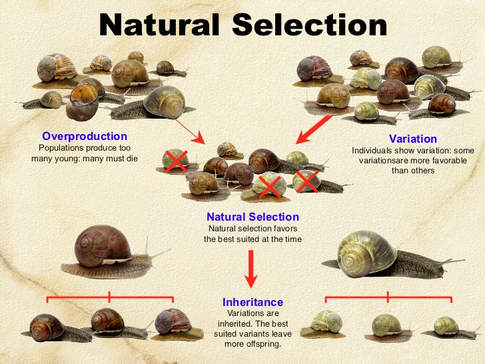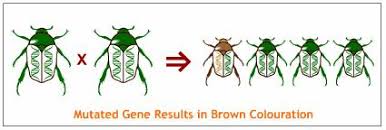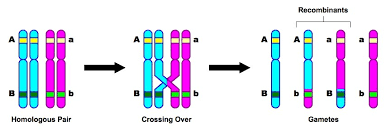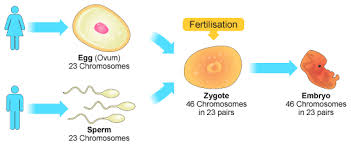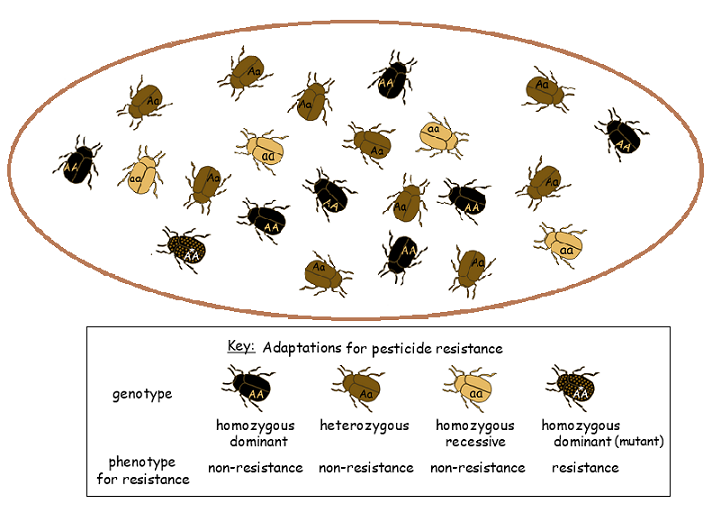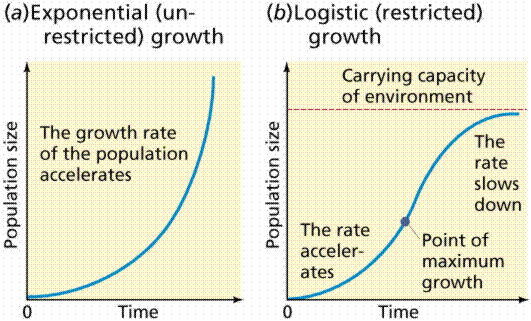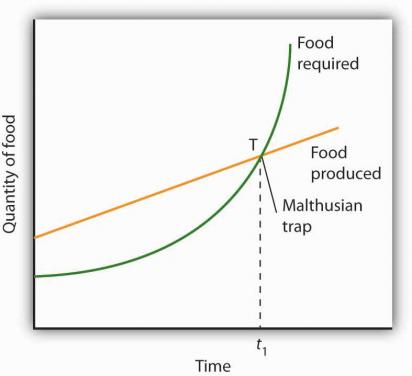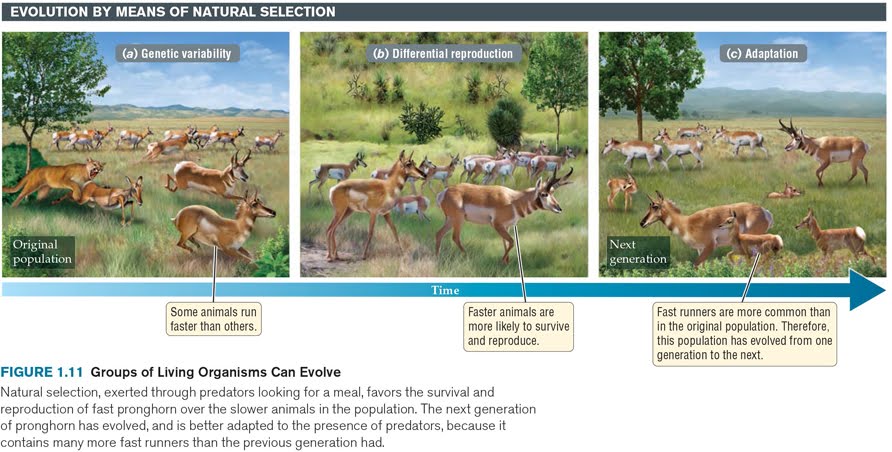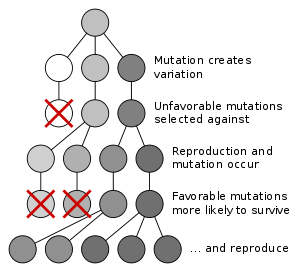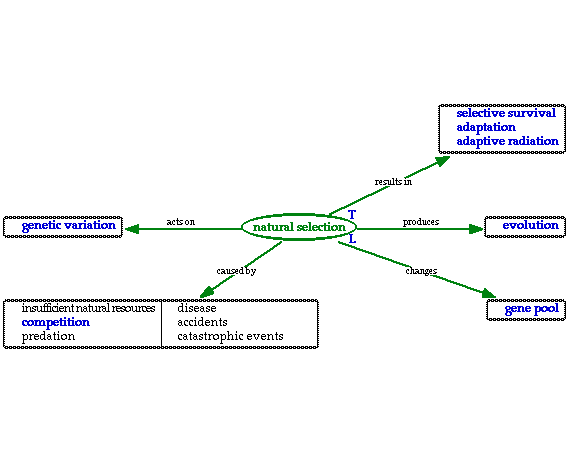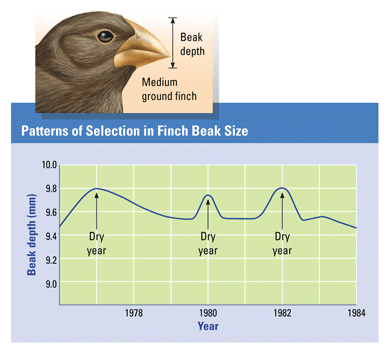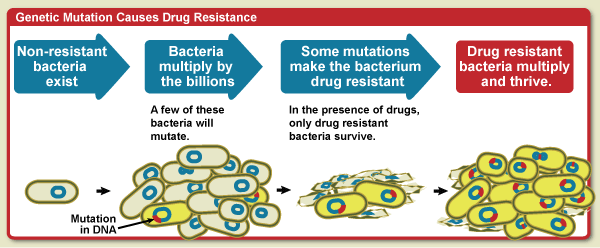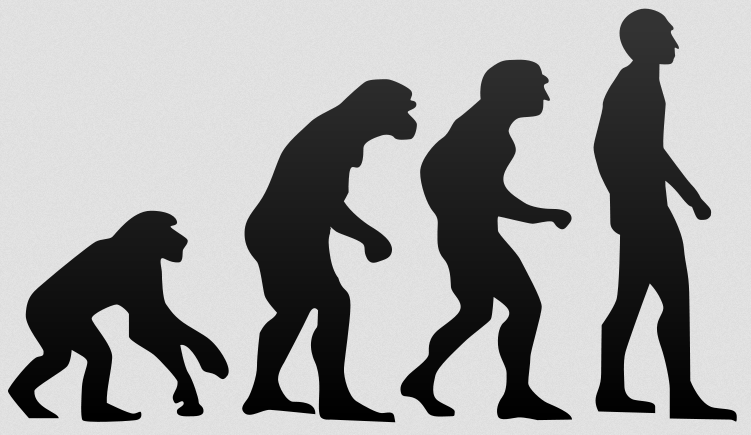- IB Style Question Banks with Solution
- IB DP Biology SL- IB Style Practice Questions with Answer-Topic Wise-Paper 1
- IB DP Biology HL- IB Style Practice Questions with Answer-Topic Wise-Paper 1
- IB DP Biology SL- IB Style Practice Questions with Answer-Topic Wise-Paper 2
- IB DP Biology HL- IB Style Practice Questions with Answer-Topic Wise-Paper 2
5.2 Natural Selection
Essential Idea:
The diversity of life has evolved and continues to evolve by natural selection
Understandings:
- Natural selection can only occur if there is variation among members of the same species
- Mutation, meiosis and sexual reproduction cause variation between individuals in a species
- Adaptations are characteristics that make an individual suited to its environment and way of life
- Species tend to produce more offspring than the environment can support
- Individuals that are better adapted tend to survive and produce more offspring while the less well adapted tend to die or produce fewer offspring
- Individuals that reproduce pass on characteristics to their offspring
- Natural selection increases the frequency of characteristics that make individuals better adapted and decreases the frequency of other characteristics leading to changes within the species
Applications:
- Changes in beaks of finches on Daphne Major
- Evolution of antibiotic resistance in bacteria
- Define variation.
- Explain why natural selection can only function if there is variation in a species.
- List sources of genetic variation.
- Define adaptation.
- List examples of adaptations.
- Use an example to illustrate the potential for overproduction of offspring in a population.
- State that species have the ability to produce more offspring than the environment can support.
- Outline how a “selective pressure” acts on the variation in a population.
- List examples of “selective pressures.”
- Explain the effect of the selective pressure on the more and less adapted individuals in a population.
- Contrast acquired characteristics with inheritable characteristics.
- State that only inherited characteristics can be acted upon by natural selection.
- Compare the reproductive success of better and less well adapted individuals in a population.
- Explain the cause of the change in frequency of traits in a population through natural selection..
- Outline the role of Charles Darwin and Peter and Rosemary Grant in the study of Galapagos finches.
- Explain how natural selection leads to changes in the beaks of Galapagos finches with changes in weather conditions.
- Explain how natural selection leads to changes in antibiotic resistance.
- List reasons why evolution of antibiotic resistance has been rapid.
- Outline the effect of not completing a full dose of antibiotics on the development of antibiotic resistance.
- List three trends that have been observed in the development of antibiotic resistance.
- Use a graph to illustrate antibiotic resistance over time
Topic 5.2 natural selection
The unit is planned to take 3 school days.
Essential idea:
- The diversity of life has evolved and continues to evolve by natural selection.
Nature of science:
- Use theories to explain natural phenomena—the theory of evolution by natural selection can explain the development of antibiotic resistance in bacteria. (2.1)
- List three trends that have been observed in the development of antibiotic resistance.
- Use a graph to illustrate antibiotic resistance over time.
5.2.U1 Natural selection can only occur if there is variation among members of the same species.
- Define variation.
- Explain why natural selection can only function if there is variation in a species.
The theory of natural selection was posited by Charles Darwin (and also Alfred Wallace) who described it as ‘survival of the fittest’. According to this theory, it is not necessarily the strongest or most intelligent that survives, but the ones most responsive to change. Within a species, different individuals of that species show genetic variation.
Individuals that are best suited for their environment will survive and reproduce. If there was no variation within a species, then all individuals would be the same and no individual would be favoured over the other and natural selection would not take place.
The process of natural selection occurs in response to a number of conditions:
- Inherited Variation – There is genetic variation within a population which can be inherited
- Competition – There is a struggle for survival (species tend to produce more offspring than the environment can support)
- Selection – Environmental pressures lead to differential reproduction within a population
- Adaptations – Individuals with beneficial traits will be more likely to survive and pass these traits on to their offspring
- Evolution – Over time, there is a change in allele frequency within the population gene pool
- List sources of genetic variation.
Natural selection requires variation among members of a species in order to differentiate survival (variation needed for selection). This variation can manifest as either discontinuous (distinct classes) or continuous (range across a characteristic spectrum)
Mutation:
- New alleles arise from the mutation of existing alleles, usually by changing one or a few base pairs
- Genetic mutations are the original source of variation within a species.
Meiosis:
- Crossing over of homologous chromosomes during prophase I results in a recombination of maternal and paternal alleles within chromosomes
- Independent assortment as homologous chromosomes randomly orient at metaphase I causing a randomized inheritance of maternal and paternal chromosomes within gametes
- During meiosis 50% of the females chromosomes will end up in the egg(haploid gamete) and 50% of the male’s chromosomes will end up in the sperm (haploid gamete).
- During meiosis chromosomes will line up or assort independently of each other creating (2n) possible variations of chromosomes in the sex cells.
- During meiosis, specifically prophase 1, crossing over might occur in homologous chromosomes where parts of each chromosome are exchanged.
Sexual reproduction:
- New combinations of alleles appear during fertilization
- As the unique set of haploid alleles in the egg
- Combine with the unique set of haploid alleles in the sperm
- Sexual reproduction can produce variation in a species through fertilization and meiosis.
- Sexual reproduction occurs when two different members of a species create offspring that have a combination of genetic material contributed from both parents.
- Random fertilization through sexual reproduction gives millions of sperms a chance at fertilizing the egg. This allows mutations that have occurred in different individuals to come together in their offspring.
5.2.U3 Adaptations are characteristics that make an individual suited to its environment and way of life.
- Define adaptation.
- List examples of adaptations.
Adaptations are features of organisms that aid their survival by allowing them to be better suited to their environment adaptations may be classified in a number of different ways:
- Structural: Physical differences in biological structure (e.g. neck length of a giraffe)
- Behavioural: Differences in patterns of activity (e.g. opossums feigning death when threatened)
- Physiological: Variations in detection and response by vital organs (e.g. homeothermy, colour perception)
- Biochemical: Differences in molecular composition of cells and enzyme functions (e.g. blood groups, lactose tolerance)
- Developmental: Variable changes that occur across the life span of an organism (e.g. patterns of ageing / senescence)
Key points to consider
- Natural selection occurs through an interaction between the environment and the variability inherent among the individual organisms making up a population.
- The product of natural selection is the adaptation of populations of organisms to their environment.
- Where and how an organism lives is largely due to its specific adaptations that allow it to survive and reproduce in a particular area or habitat
- In other words their structure allows them to function in that environment
- Polar bears are well adapted to life in the Arctic. They have a large layer of blubber to keep them warm. They are strong swimmers, aided by their strong forearms and layer of blubber for buoyancy. They have hollow fur to aid in insulation as well. For plants, cacti have water storage tissue and spines (prevent water loss) because of the infrequent rainfall in the desert.
5.2.U4 Species tend to produce more offspring than the environment can support.
- State that species have the ability to produce more offspring than the environment can support.
- Use an example to illustrate the potential for overproduction of offspring in a population.
The Malthusian dilemma was proposed by English clergyman Thomas Malthus who identified that populations multiply geometrically (i.e. exponential progression), while food resources only increase arithmetically (i.e. linear progression). In other words, species tend to produce more offspring than the environment can sustainably support.
Populations tend to produce more offspring than the environment can supporter that could survive in a particular community or ecosystem. For example, fish produce thousands of eggs but only few make it to adulthood.
Plants also can produce hundreds or thousands of seeds to be released into the environment. When parents don’t spend a lot or even any time caring for their young, they produce many offspring. This is a reproductive method used to make sure some offspring make it to the next generation. Parents that put a lot of time and energy protecting and raising their young tend to have far smaller litters, i.e. most mammals.
The population density that the environment can support is called the carrying capacity. If there are too many organisms, the demand for resources increases. However, there is a limited supply of resources in an ecosystem.
Overpopulation and a limited amount of resources creates competition within a population.
- All species have such great potential fertility that their population size would increase exponentially if all individuals that are born reproduced successfully observation
- Populations tend to remain stable in size except for seasonal fluctuations.
5.2.U5 Individuals that are better adapted tend to survive and produce more offspring the less well adapted tend to die or produce fewer offspring.
- Outline how a “selective pressure” acts on the variation in a population.
- List examples of “selective pressures.”
- Explain the effect of the selective pressure on the more and less adapted individuals in a population.
Organisms with less desirable traits will die or produce less offspring
- observation 3: Environmental resources are limited.
- inference 1: Production of more individuals than the environment can support leads to a struggle for existence among individuals of a population, with only a fraction of offspring surviving each generation (= struggle for existence).
[Students should be clear that characteristics acquired during the lifetime of an individual are not heritable. The term Lamarckism is not required.]
- Contrast acquired characteristics with inheritable characteristics.
- State that only inherited characteristics can be acted upon by natural selection.
this unequal ability of individuals to survive and reproduce will lead to a gradual change in a population, with the inheritance of favorable characteristics accumulating over the generations.
In other words: Natural selection is differential success in reproduction ( unequal ability of individuals to survive and reproduce).
These organisms that survive and reproduce, pass these beneficial traits onto their offspring. Over many generations the accumulation of these beneficial genetic traits may result in a change in the population known as evolution.
For another species to develop, these genetically different individuals eventually have to become reproductively isolated (separated from the general population) where they will only reproduce with individuals with similar genetic traits.
Acquired characteristics of an individual such as large muscles are not passed on to an organism’s offspring
5.2.U7 Natural selection increases the frequency of characteristics that make individuals better adapted and decreases the frequency of other characteristics leading to changes within the species.
- Compare the reproductive success of better and less well adapted individuals in a population.
- Explain the cause of the change in frequency of traits in a population through natural selection.
Evolution is the cumulative change in the heritable characteristics of a population, or the changes in allelic frequencies in the gene pool of a population over time, as a result of natural selection, genetic drift, gene flow, and mutation pressure
Since the better adapted individuals of a species are the ones that survive, reproduce and pass their genes on to the next generation, these alleles will become more frequent within the population. The same would hold true for individuals that are less suited to an environment. These individuals will reproduce less frequently and die more often, thus decreasing the frequency of their alleles within a population. These changes happen over many generations
5.2.A1 Changes in beaks of finches on Daphne Major.
- Outline the role of Charles Darwin and Peter and Rosemary Grant in the study of Galapagos finches.
- Explain how natural selection leads to changes in the beaks of Galapagos finches with changes in weather conditions.
- yearly variation in rainfall in the Galapagos Islands can be extreme due to the weather cycles known as El Nino
- in wetter years, all sizes of seeds are available in large numbers
- that is, the frequency of the smaller beak alleles increases over time
- smaller birds with smaller beak sizes eat more efficiently and have higher rates of surviving and reproducing
- smaller beaked birds pass on the trait of smaller beaks to their offspring
- as a result, in the following year the average beak size decreases
- in dryer years, smaller seeds are quickly consumed, leaving only larger, harder seeds that is, the frequency of the larger beak alleles increases over time
- larger birds with larger beak sizes eat more efficiently and have higher rates of surviving and reproducing larger beaked birds pass on the trait of larger beaks to their offspring as a result, in the following year the average beak size increases
- As predicted by evolutionary theory, natural selection produces gradual changes in traits in response to changes in the environment
5.2.A2 Evolution of antibiotic resistance in bacteria.
- Explain how natural selection leads to changes in antibiotic resistance.
- List reasons why evolution of antibiotic resistance has been rapid.
- Outline the effect of not completing a full dose of antibiotics on the development of antibiotic resistance.
Antibiotics are chemicals produced by microbes that either kill (bactericidal) or inhibit the growth (bacteriostatic) of bacteria. Antibiotics are commonly used by man as a treatment for bacterial infections (not effective against viral infections). In a bacterial colony, over many generations, a small proportion of bacteria may develop antibiotic resistance via gene mutation.
Shortly after development of antibiotics (e.g. penicillin) nearly all bacteria were killed during an application of antibiotics
- some variants of bacteria had a heritable trait that gives them resistance to antibiotics
- the resistant bacteria have higher rates of surviving and reproducing
- resistant bacteria pass on the trait of antibiotic resistance to their offspring
- in each following generation the percentage of antibiotic resistant bacteria increases
- that is, the frequency of the antibiotic resistance alleles increases over time
- As predicted by evolutionary theory, natural selection produces gradual changes in traits in response to changes in the environment
- Resistance can be passed onto other pathogenic bacteria, creating more species of resistant bacteria.
- Some examples of bacteria known to develop resistance are Treponema pallidum which causes syphilis and the bacteria that causes tuberculosis (Mycobacterium tuberculosis)
Evolution
Table of Content
- Definition of Evolution
- Example of Evolution
- Mechanism of Evolution
- Natural Selection
- Types of Natural Selection
- Darwin’s Theory of Evolution
- Modern understanding
- Evolutionary Change
- Human Evolution
- Frequently Asked Questions
Definition of Evolution
“Evolution is change in the heritable characteristics of biological populations over successive generations. Evolutionary processes give rise to biodiversity at every level of biological organization, including the levels of species, individual organisms, and molecules.”
Example of Evolution
Peppered moth initially had light colored which was darkened after Industrial Revolution, due to population. This mutation occurred because light colored moths were easily seen by birds, therefore, darkening of them helped in surviving from birds.
Example of Evolution and Mechanism of Evolution
“Microevolution refers to the change in allele frequencies within a single population.” Allele frequencies changes due to four major forces of evolution, i.e. Natural Selection, Genetic Drift, Mutation and Gene Flow.
What drives evolution: Mutation or Genetic Recombination?
Mutation and genetic recombination are the two possible sources that results in genetic variability. “Mutations are random nucleotide alterations such as copying errors or changes induced due to external mutagens.” On contrary, “genetic recombination is performed by the cell during the preparation of gametes (pollen, egg or sperm) that are used during sexual reproduction.”
Both of these processes contribute to the evolution of an organism but genetic recombination is considered as the primary source of enabling genetic distinctions between individuals in a population and is therefore, considered as principal driving force that results in evolution.
Natural Selection
Natural selection is the basic mechanism of evolution along with migration, mutation and genetic drift.
Definition of Natural Selection
“The process whereby organisms better adapted to their environment tend to survive and produce more offspring is referred as natural selection.” The adaptation takes place by means of selectively reproducing changes in its genetic constitution.
Example of Natural Selection
Tree frogs are sometimes eaten by birds and snakes. Amongst these grey tree frogs blend well in the areas with dark wood tree bark while green tree frogs blend well with green vegetation found in swamp and marshes.
A green tree frog on bark of tree is easy to be found by predator as compared to a green tree frog on green leaves. So, natural selection has favored those tree frogs that live in habitats in which they are more camouflaged.
In natural selection, the variations in genotype which increases the chances of survival of an organism and procreation are retained and multiplied in generations at the expense of less advantageous ones. Thus, natural selection arises from the differences in survival in rate of development, in fertility, in mating success and several other aspects. These all differences result in natural selection to the extent that they impact the number of progeny.
Gene frequencies remain constant in different generations in the absence of any disturbing factors. The factors that can create disturbances are migration (gene flow), mutation and random genetic drift.
Types of Natural Selection
- Stabilizing Selection – “When selective pressures select against the two extremes of a trait, the population experiences stabilizing selection.” Let us consider an example of plant height. A plant that is too short is not able to compete with other plants while the extremely tall plant may be more susceptible to wind damage. When these two selection pressures are combined, it helps in maintaining the medium plant height. As a result of stabilizing selection, the number of plants with medium height will increase, while tall and short ones will decrease.
Following figure shows the selection against two extreme traits
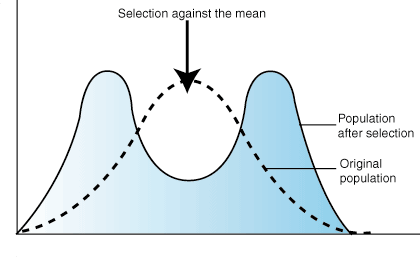
Figure 2
- Directional Selection – “In direction selection, one extreme of the trait distribution experience selection against it.” As a result of this selection, the population trait distribution shifts towards the other extreme. Considering the example of giraffe, there was the selection pressure against short necks as they were not able to reach the leaves of the trees. As a result, the distribution of length of neck was shifted in the favor of giraffes, i.e. the individuals with longer neck.
Following figure shows the effect of directional selection on trait distribution
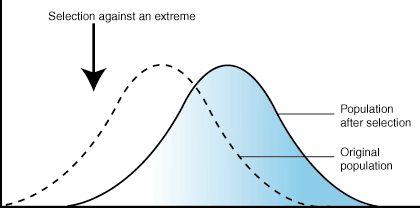
Figure 3
- Disruptive Selection – “In disruptive selection, selection pressures act against individuals in the middle of the trait distribution.” The outcome may be two peaked or bimodal. Consider an example of a plant with variable height pollinated by three different pollinators, i.e. one attracted to short plants, second attracted to medium plants and third visit only the tallest plant. If the pollinators which preferred plant height are disappeared from the area, medium height plants will be selected against the population of short and tall plants. Such a population, with several distinct forms is referred as polymorphic.
Following figure shows the effect of disruptive selection on trait distribution.
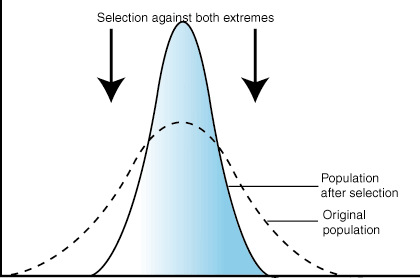
Figure 4
Darwin’s Theory of Evolution
This theory of evolution is one of the most substantiated theories in the science history because it is supported by wide variety of scientific disciplines i.e. geology, paleontology, developmental biology and genetics. The theory of evolution was first formulated by Charles Darwin in the year 1859. According to him, organisms change overtime behaviorally or physically. These changes allow the organisms to adapt to the environment such that they are able to survive and have more offspring.
The two main points of this theory are as follows –
- “All life on earth is connected and related to each other.”
- “The diversity of life is the product of modifications of population by natural selection.”
Modern understanding
Darwin was not aware of genetics, rather he observed only the pattern of evolution. After the discovery of genes, its importance, behavioral or physical traits and passing of genes were studied later. This resulted in corporation of genetics and Darwin’s theory which was termed as “Modern Evolutionary Synthesis.” According to this theory, the behavioral and physical change that occurs as a result of natural selection happens at DNA level and such changes are called mutations. Mutation can also cause random error in replication or repair of DNA due to radiation or chemical damage. In several cases, mutation can be neutral or harmful, while in some cases it also proves beneficial to the organisms.
Evolutionary Change
It is the constant process of gradual changes in physical or behavioral traits of organisms. It is the slow and continuous process. Evolutionary changes takes in following manner –
Catastrophism and Gradualism – Evolution includes change over the period of time. In catastrophism, the pattern of evolution is based on assumption that several catastrophic events separate the distinctive boundaries on fossil record. These catastrophes are floods, volcanic eruptions or droughts. This theory was proposed by George Cuvier. According to him, these catastrophic events have the local impact and thus, affect the organisms living in that specific area. Extinction of dinosaurs is considered as the result of catastrophic events.
On contrary to catastrophism, as per gradualism, changes take place continually over a long period of time. Thus, according to it, change did not occur as a result of huge event, rather it a gradual process whereby change takes place from generation to generation.
Human Evolution
“It is the evolutionary process that led to the emergence of anatomically modern humans.” The study of human evolution involves several scientific disciplines, such as primatology, anthropology, paleontology, archaeology, ethology, neurobiology, evolutionary psychology, linguistics, genetics and embryology.
Human evolution is a lengthy process and includes the change of present humans from ape like ancestors. As per the available scientific evidences, our behavioral and physical traits are originated from ape like ancestors and have gradually evolved over a period of approximately 6 million years.
Bipedalism (ability to walk on two legs) is one of the earliest defining traits which evolved 4 million years ago. Other characteristics like large and complex brain, capacity for language, ability to use and make tools, etc. were recently developed.
The process of Evolution
The process of evolution includes series of natural changes that cause species to arise, adapt to environment and become extinct. All organisms and species are the outcome of process of evolution. Evolution occurs with the change in genetic material that is inherited from parents. Here, genes represent “the segment of DNA that provide the chemical code for producing proteins.” Evolution does not change any single individual rather it changes the inherited means of growth and development. Parents pass genetic changes that are adapted to offspring and finally these changes become permanent or common throughout the population.
Frequently Asked Questions (FAQs)
Q1: Define mutation, migration and random genetic drift.
Answer: The term mutation is defined as “the spontaneous change in the gene frequency that takes place in population and occurs at low rate.”
“Migration is the local change in gene frequency when an individual moves from one population to another and then interbreeds.”
“Random genetic drift is the change that takes place from one generation to another by the process of pure chance.
Q2: How does the species evolve?
Answer: The changes in DNA takes place as it passes from one generation to another. DNA mutations sometimes affect the appearance of animals and sometimes the way in which boy works. Majority of times, the new version of gene survives better than an animal of old version and as per “survival of fittest” theory offspring adapt those changes and thus, evolution of species takes place.
Q3: What is adaptive radiation?
Answer: “In evolutionary biology, adaptive radiation is the process in which organisms diversify rapidly from an ancestral species into the multitude of new forms, particularly when a change in the environment makes new resources available, create new challenges or open new environmental niches.”


